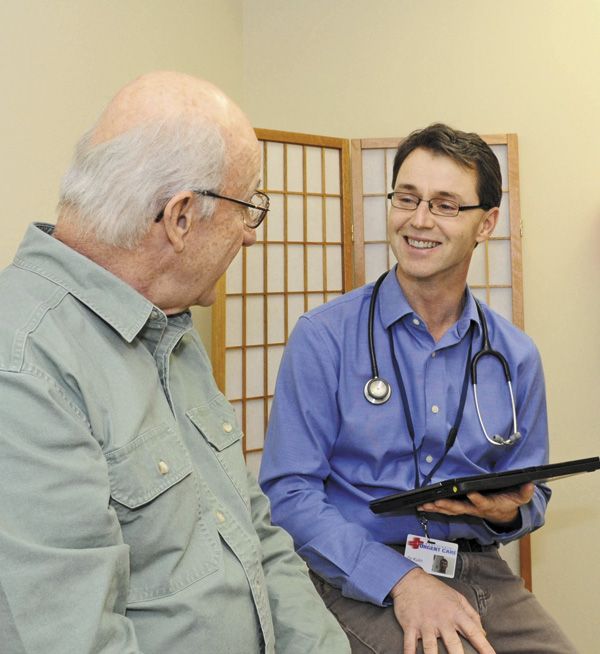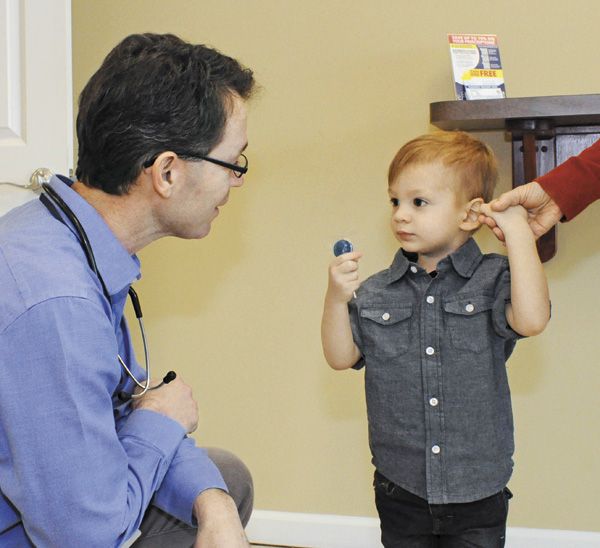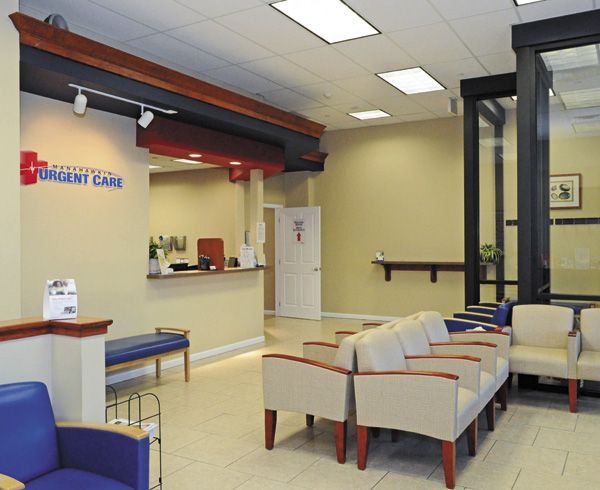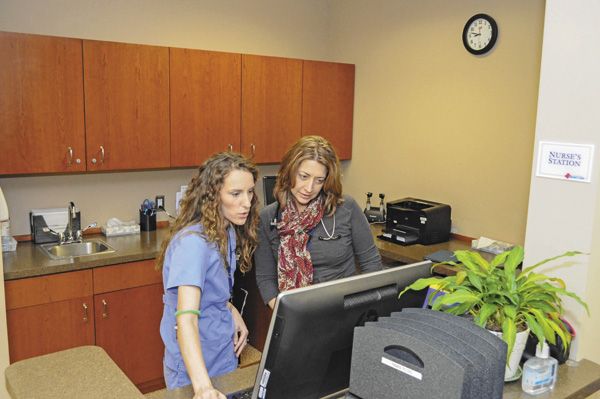Article
Practice Innovators: Building for success
In this Practice Innovators profile, Medical Economics looks at how John Kulin, DO, makes customer service an important part of treating patients.
The clock starts ticking for John Kulin, DO, and his staff the moment a patient walks in the door at Urgent Care Now. Each step along the way is tracked, from door to registration, to how long it takes a patient to get in front of a provider and the length of the encounter.

John Kulin, DO, with a staff member at one of Urgent Care Now's clinicsAll of these metrics are tracked with one goal in mind: To provide patients with fast, friendly and effective care, in a manner that makes clear that patients’ time and health concerns are of paramount importance, just as important as the time of the physicians and nurses. “Patients expect quality care,” Kulin says. “They expect to have friendly service and friendly staff, so we need to make sure those things are in place.”
It’s one thing to aspire to that-all practices do. But delivering on that promise while beset by the daily challenges of running a practice is another thing entirely. What Kulin’s practice takes pride in is blending the old fashioned notion of customer service with an effective use of technologies and approaches to engaging patients, motivate staff members and, ultimately, supercharge revenue.
Kulin’s practice is growing, through both expansion and increased patient volume, and it’s happening at a time when independent practices of all kinds are struggling. As a result of its success, Kulin was selected as one of Medical Economics’ innovators, in hopes of sharing some of his successful strategies. These include:
- emphasizing customer service and patient satisfaction by shortening wait times and engaging with patients outside the office through use of the patient portal,
- leveraging appropriate technology-including electronic health records, a patient portal and consumer technology such as iPads-and carefully integrating it into his workflow and patient outreach efforts,
- coordinating care by partnering with the primary care practices in his area to ensure that patients who visit his urgent care aren’t lost in the shuffle, and that their physicians are kept up to date on the care they receive,
- building a goal-oriented, unified company culture that ensures all employees are working at the top of their licenses and share in the vision and goals of the organization, and
- planning a carefully laid out growth and expansion strategy that emphasizes location and replicating past success into new ventures.
As our nation’s healthcare system undergoes rapid changes, entrepreneurs are searching for opportunities to fill existing care gaps. One of those gaps is urgent care- acute injuries or illnesses that are not serious enough for the costly and time-consuming hospital emergency department but too time-sensitive to wait for an appointment with a primary care physician.
Enter urgent care centers: A convenient middle ground that fits a clear need for today’s busy patients. While urgent care is not a new concept, investors clearly believe in its ability to fill this gap in today’s healthcare world: private equity firms have invested more than $2.3 billion in urgent care businesses since 2008, and regional health systems and hospitals have opened their own urgent care centers, according to the New York Times.
Kulin opened his urgent care center for a similar reason: He strived for years as an emergency department physician and director to figure out a way to treat these urgent-but-not-emergency patients more efficiently. “It was frustrating trying to work through systems to get them in and cared for in a proper fashion, and after many iterations in the hospital, it just was not working,” he says. “That was the initial impetus to open an urgent care center.”
But opening does not equal automatic success, as Kulin quickly discovered in 2005. After departing his position as the medical director of the emergency department at Southern Ocean Medical Center, Kulin opened his first center in Manahawkin, New Jersey, where he made his share of mistakes, and was not fully prepared for the business challenges of running a startup, independent medical enterprise. But he survived and learned his way to success, he says.
“I would like to think we physicians are all smart individuals, but when it comes to business, most of us are not,” Kulin says. “We have to learn and go through things and make mistakes, and you see practices fail along the way. If I could go back, I would have got my MBA before I went into opening an urgent care center. I wish I had more business acumen going into it years ago. Going out and going on my own, it was through working my backside off that I survived.”
NEXT: Customer service at Urgent Care Now
Customer service
All patients know this feeling: Walking into a medical practice and waiting to check in. Next comes the waiting to be called. Then, alone in the exam room for two more rounds of waiting, first for the nurse then, at long last, for the physician.
Kulin believes the time it takes a patient to receive service is a defining factor in whether a patient will be satisfied with the care he or she receives. Kulin has built a patient flow system that emphasizes shortening wait times. Everything is focused on making it easier for the patient. “We continue to try and focus on: How do we find ways to make it easier for the patient in terms of quality, safety, access, communication with patients as well as with other providers?” Kulin says.
Before walking in the door, patients can check the Urgent Care Now website to learn the current wait times at the various locations. This allows patients to plan their visits when it is best for them, while at the same time ensuring that patients expectations of wait times are realistic.
Related:Engaging patients to decrease costs and improve outcomes
When patients enter, they first encounter two iPads set up for registration. More than 90% of patients use the iPads to register, a process that takes as little as 10 seconds. Patients can use the iPad to make copayments, enter medical history and current medications, thereby saving staff time and allowing medical history and other information to become a discussion topic with patients, rather than a rote clerical job.
The practice also offers a text notification service to alert a patient when he or she is about to be called back, so patients don’t have to sit in the waiting room. “To me, the worst thing is someone who is ill or injured and now are sitting in a waiting room surrounded by other people in the same situation. It’s adding insult to injury,” Kulin says.

John Kulin, DO, with senior patient
Most of the metrics that Kulin tracks and analyzes, with the help of custom reports his nurse manager has developed in the practice’s EHR system, are directly related to how long it takes patients to move through the encounter process and, by extension, how efficient his front office staff and providers are at accomplishing that. Important metrics include:
- check-in and check-out productivity,
- time spent chart documenting,
- the rate of same-day chart close,
- ordering of x-rays and other diagnostic tests,
- ordering of prescription drugs,
- overall visit time,
- patients seen per hour, and
- tracking e-mail collection for patient portal sign-up and phone number capture for secure messaging
Kulin knows the results for many of these metrics by heart. For example, he knows that his providers, across all his locations, average about 3.1 minutes on chart documenting, which in turn tells him a number of things-for example, how long providers are spending on documentation versus speaking with and treating the patient, a metric that affects how many patients each provider can see in an hour. The goal, Kulin says, is about 3 to 3.5 patients per hour.
“There are a bunch of different things we have in our dashboard,” Kulin says. “It allows us to look at the 10,000-foot view and drill down when we see an outlier, whether positive or negative, and using that outlier as an educational opportunity or include in best practices if someone has figured out a better way of doing something.”
NEXT: Using technology at Urgent Care Now
Technology
While many physicians regard their EHR as a problem that has to be overcome, Kulin sees his EHR and its vendor as a solution, and a business partner.
Kulin says his EHR enables Urgent Care Now to:
- attest to meaningful use 2,
- track a host of metrics to gauge productivity and develop workflow best practices,
- grease the workflow through easy-to-use patient interfaces, such as the registration iPads, and
- enable secure communication with patients through a patient portal to address immediate needs, including prescriptions and test results.
“I believe technology should never get in the way of the patient interaction and it shouldn’t if done right,” Kulin says. “We should be using technology to enhance face time of the provider with the patient, and everything we do is focused around that.”
The key to using technology in practice, he says, is to find the solutions that “make us more efficient and better” and to re-evaluate when that’s not happening. For example, when Kulin sees a patient, he brings a tablet with him and sits across from the patient to discuss the record. This creates two positive outcomes: the documentation process becomes part of the patient discussion, rather than an extra step, and it speeds up encounters to allow for greater provider efficiency.
Related:Satisfaction with EHR systems grows among physicians
One way that Kulin’s business has engaged patients through technology is with secure messaging. Among the spurs for doing this was attesting to meaningful use, but completing the requirement was challenging for an urgent care center. Urgent Care Now succeeded by scripting conversations to ensure that patients receive the same message from all staff members about the importance of signing up to use the portal.
One way they have convinced patients to do so was by guaranteeing that a secure message sent to the urgent care staff would receive a prompt response. Kulin says the average response time to a patient message is 15 minutes.

John Kulin, DO, (left) meets with a young patient at one of his urgent care clinicsReaching out via secure messaging and the portal has had another interesting side effect: helping to meet quality measures for antibiotic prescribing, since a common challenge for urgent care centers is patients seeking antibiotics, regardless of whether an infection is bacterial or viral.
Kulin understands the constant “ethical battle” between making a patient happy and providing high-value, evidence-based care. The secure messaging option has helped open a third alternative between acquiescing to a patient demand for antibiotics and flatly refusing, by allowing providers to explain to patients that, for example, their illness is viral, but that if the patient doesn’t improve he or she can always contact a provider through the portal.
“Since patients have adopted secure messaging, we have seen a dramatic increase in the patients who are willing to say: ‘that’s fine, I understand, if it changes, I will let you know right away,’” Kulin says. “It has dramatically decreased our prescribing of antibiotics for upper-respiratory things, which has been a wonderful side effect of meaningful use and secure messaging. I was quite surprised to see it.”
Kulin is a technology evangelist who sees benefits in meaningful use and a promising future for population health and data analytics. He also serves as chief medical officer for Urgent Care Integration Network, a nationwide management services organization that started in 2014 and plans to use a network of 19 urgent care centers to develop clinical guidelines, best practices and, perhaps most interestingly, to share data from more than 200,000 patient encounters annually across the network.
“With 200,000 visits per year, suddenly there are data trends you can see differently,” he says. “In the next 10 years, I think the major advances we are going to see are by recognizing trends in patient populations and using data gathered to really develop that. We are looking to do that and get ahead of the curve.”
NEXT: Care coordination
Care coordination
Primary care physicians may feel that urgent care centers, and their retail clinic cousins, are competitors seeking to slice away at their patient base and revenue.
But Kulin does not view himself that way. Instead, he says, his urgent care partners with primary care physicians to improve patient care by building systems to ensure care is continuous, timely and high quality. Technology helps with this, as does having systems in place to ensure that his staff follows up with patients’ primary care physicians and talks with them about care issues. Kulin says his practice “focuses on being an extension of their office.”

Interior of Urgent Care Now's Manahawkin, New Jersey, location
“Primary care physicians are my friends,” Kulin says. “They are worried about trying to keep their schedules filled and make sure they are being as efficient as possible. For them, trying to leave spaces in their schedule for emergencies and urgencies that come up can become problematic and actually detract from their bottom line. So we are trying to do our best to keep a good working relationship.”
Kulin’s practice takes several steps to ensure that Urgent Care Now is part of a continuum of care for patients, and not used as a replacement for primary care service. They include:
All patients who come in without a primary care physician have a discussion with the staff about the importance of primary care and are given a referral list of physicians that Urgent Care Now works with.
When patients do have a primary care physician, that provider is notified after every patient visit to Urgent Care Now so, as Kulin says, “they know exactly what is going on with their patients.”
Related:Referrals and liability: What primary care physicians need to know
Patients on Kulin’s email list are sent screening guideline reminders, with pertinent statistics and information, and are asked to talk to their primary care physician about their options. These campaigns provide name recognition for Urgent Care Now while “driving patients back to their primary physicians to have these conversations.” In March of 2014, Kulin deployed more than 18,000 emails to patients over the age of 50 reminding them to be screened for colorectal cancer as part of National Colorectal Cancer Awareness Month. This year, the number was 26,000.
“Hopefully, we are able to further support our primary care brethren as well as help them to have that discussion with their patients in a more friendly fashion,” Kulin says. “If the patient brings it up, it gives a little more weight.”
NEXT: Company culture
Company culture
Kulin’s roughly 60-person staff includes 10 physicians and eight nurse practitioners (NPs). He is in the process of hiring four more physicians and another NP.

Staff members at Urgent Care Now at a work stationFinding the right people is a crucial part of the success of any organization. Beyond basic qualifications and certifications for the job, what’s most important is the person’s attitude and approach rather than any specific skill sets they bring to the interview, Kulin says.
“Do they fit into our culture?” Kulin says. “We have a patient-centric, retail culture. Patients are hurting, patients are sick. They do not want you being grumpy, so we hire for culture. I can train people to do any task, when it comes down to it. I cannot change what their culture is and whether they fit into this.”
Related:The importance of in-person staff meetings
One of the most important aspects of building success for his expanding practice is consistency among staff members, processes and locations. “If you set certain quality and safety standards for your organization, that needs to be throughout your organization, no matter where you are,” he says. “As we found our efficiencies for registration, for x-rays, for nursing and everything else, we worked out what each of these people do and how they can function at the highest level of their abilities, training, and licensure. That allows us to give back consistent products across the board.”
The future
Ten years since opening his first center, Kulin believes he’s built efficient workflow processes, developed the right employee culture, and leveraged the best technology solutions Urgent Care Now needs for sustained success.
In January, he opened a second facility in Lannoka Harbor, New Jersey, and that urgent care center is already profitable and averaging 44 patients per day. Another center is expected to open later this year in Toms River, New Jersey, and Kulin says he is exploring further expansion options.
For physicians looking to expand their practices or start a new venture, Kulin says becoming an expert on the business side-or finding someone you trust to run the business side for you-is invaluable.
“I feel we are in a great spot for expansion, because we have our processes laid out and repeatable and always looking for better ways to do things,” Kulin says. “I love the ability to care for patients and guide our practice. I hope I am still doing it in 10 years.”
NEXT: Takeaways on Urgent Care Now from John Kulin, DO
Takeaways for primary care practices
What are some techniques used in Urgent Care Now that independent practices can adopt?
- Culture is everything. Hire for cultural fit, tasks are easy to teach.
- Don’t see problems, see solutions. Train your staff to constantly look for solutions to the problems we all face.
- See your practice from the patient perspective. Does anyone really like paper gowns?
- Cause disruption. As a new practice think of how you can do things better than you competitors, as a mature practice think of how your competitors would disrupt your practice and make those changes first.
- Run a lean, nimble organization.Small practices have an advantage in being able to adjust and move quickly to meet evolving business and patient needs. Also, medicine is increasingly based on narrower margins-being aware of this is key.





